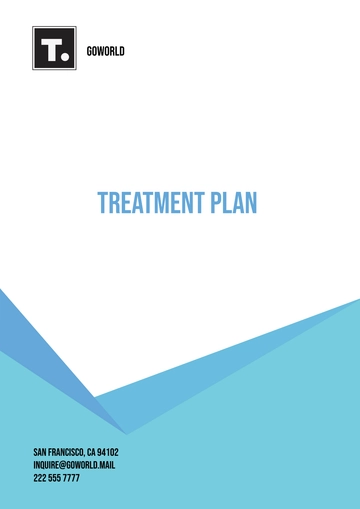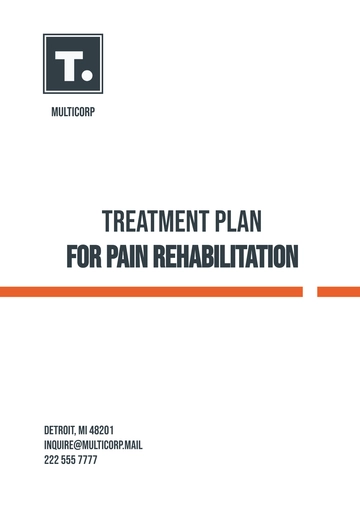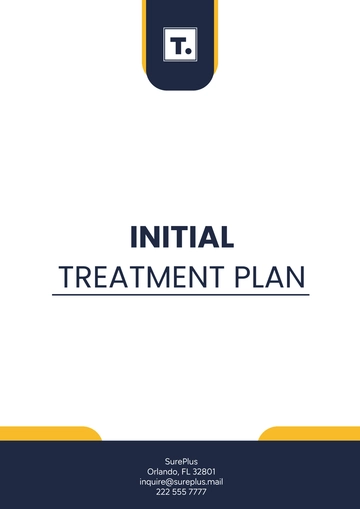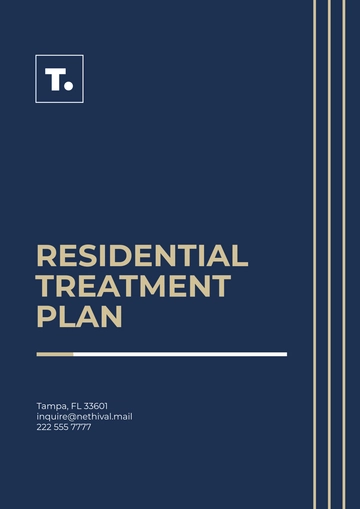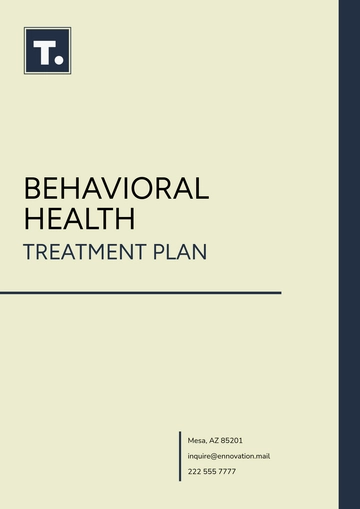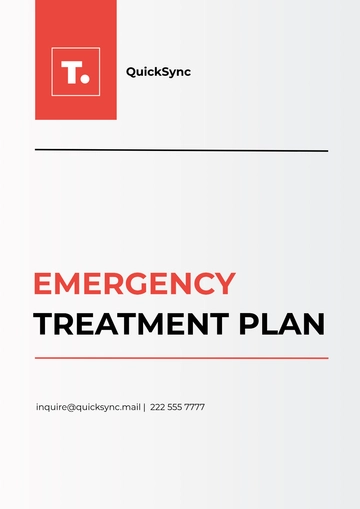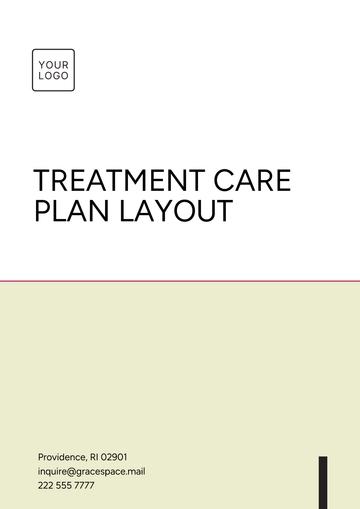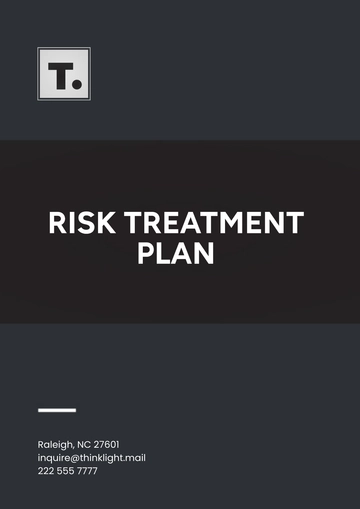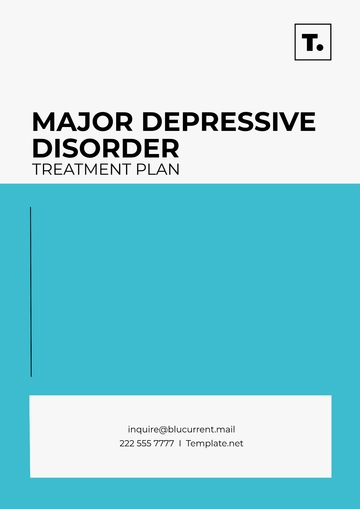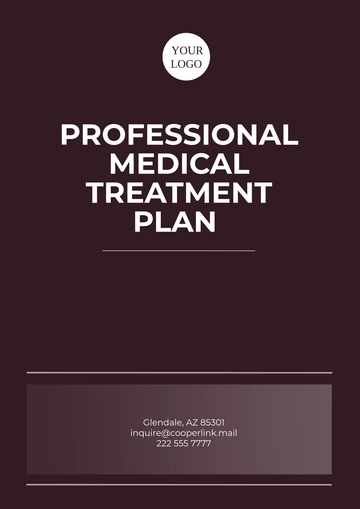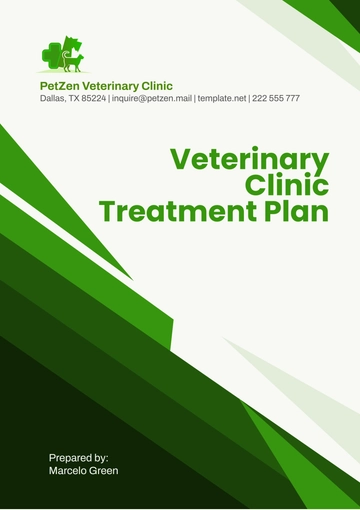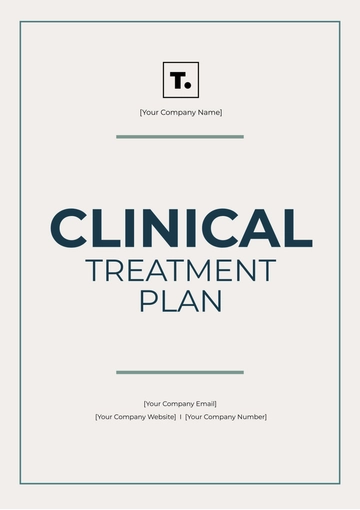Free Veterinary Clinic Treatment Plan
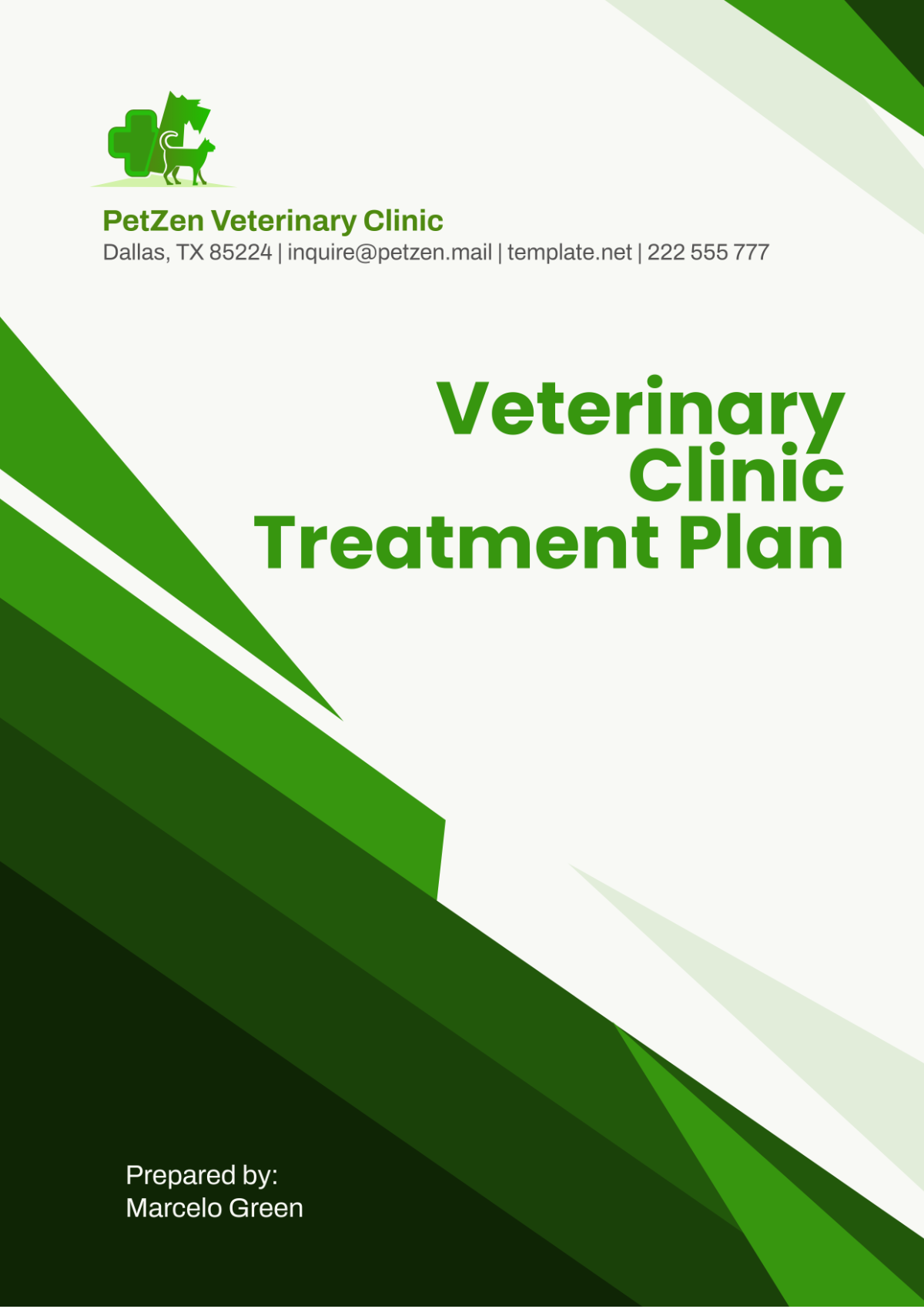
1. Introduction
The Veterinary Clinic Treatment Plan is a vital framework designed to ensure the most effective and high-quality care for animals at [Your Company Name]. It comprehensively outlines the steps and processes that veterinarians and veterinary technicians follow to diagnose, treat, and manage various medical conditions in pets. The treatment plan ensures that each pet's specific needs are met, whether it's for routine check-ups, treatment of acute or chronic conditions, post-surgical recovery, or end-of-life care. By following a systematic approach, we are able to enhance the efficiency of care delivery, reduce the risk of errors, and ultimately improve the outcomes for our patients.
This treatment plan is adaptable and can be modified as the patient's condition evolves, ensuring that the veterinary team is always equipped with the best approach to the pet's health at any given moment. It is a key component in our commitment to transparency, continuity, and the ongoing development of treatment protocols. Moreover, it serves as a communication tool between [Your Company Name] and pet owners, ensuring that they are kept informed and involved in the care process, which fosters trust and collaboration.
2. Purpose of the Treatment Plan
The purpose of the treatment plan is to create a clear, structured approach to animal healthcare that achieves the following objectives:
Comprehensive Care: The plan provides a comprehensive overview of the pet's health, ensuring no aspect of the pet's medical needs is overlooked. This includes detailed documentation of the pet’s clinical history, current diagnosis, treatment options, and expected outcomes.
Specific Treatments: It serves as a roadmap for the various treatment methods that will be employed. These may range from prescribed medications to specialized procedures or therapies, ensuring that every aspect of care is catered to with precision.
Timelines for Care: Establishing a clear timeline for each phase of treatment ensures that both the veterinary team and pet owners are on the same page. It helps manage expectations and allows for the timely reevaluation of progress.
Transparency and Communication: The treatment plan fosters transparency in the decision-making process and establishes a clear channel for communication between [Your Company Name] and pet owners. It allows owners to make informed decisions about their pet’s care and encourages them to actively participate in the treatment process.
Patient Monitoring: The treatment plan outlines procedures for ongoing monitoring, including regular check-ups, re-assessment of symptoms, and adjustments to medication as needed. This ensures that the pet’s treatment is dynamic and adaptable to changes in their condition.
By using a detailed treatment plan, the veterinary clinic is better equipped to provide individualized, high-quality care that takes into account both the pet's health status and the owner’s preferences and concerns.
3. Initial Consultation
3.1. Patient History
The initial consultation is one of the most important steps in crafting a personalized treatment plan. The veterinary team will begin by gathering a thorough and accurate patient history, which provides valuable insights into the pet’s past and current health. This includes the following details:
Pet’s Age: Age is a key factor in diagnosing and treating many health conditions. Younger pets may require preventive care, vaccinations, and sterilization, while older pets may need more frequent check-ups to monitor chronic conditions such as arthritis, kidney disease, or heart problems. Additionally, some medical issues are more common in certain age groups, and this helps guide the veterinary approach.
Breed Information: Some breeds are genetically predisposed to certain health conditions. For example, large dog breeds may be more prone to hip dysplasia, while small dog breeds may be more susceptible to dental issues. Understanding the breed helps veterinarians anticipate potential risks.
Previous Medical History: A record of any previous illnesses, surgeries, or medical treatments is crucial. This information can help the veterinary team anticipate any complications or conditions that may recur or need to be monitored.
Vaccination Status: An up-to-date vaccination record is essential in preventing contagious diseases, such as rabies, parvovirus, and distemper. If the pet’s vaccination history is incomplete or missing, necessary vaccines will be administered during the consultation.
Dietary Habits: Diet plays a significant role in an animal’s overall health. Understanding the pet's current diet—whether it’s commercial, homemade, or special therapeutic food—can help diagnose potential food allergies, intolerances, or obesity-related conditions.
Lifestyle and Activity Level: Understanding a pet's daily activity level, such as how often they exercise and their environment (e.g., indoor or outdoor), can provide clues to their overall health. Pets that are more active may face different risks than sedentary pets, and this information can help in tailoring treatment recommendations.
3.2. Physical Examination
The physical examination is a detailed assessment of the pet's body, looking for any abnormalities or signs of disease. The veterinary team will examine the following areas:
General Condition: This includes assessing the pet’s overall body condition score (BCS), which helps determine whether they are underweight, overweight, or at an ideal weight. BCS is a critical indicator of the pet’s health and can point to dietary issues, obesity-related conditions, or malnutrition.
Vital Signs: Taking the pet’s temperature, heart rate, and respiratory rate is a key part of the physical exam. These indicators provide a snapshot of the pet’s current health status. Abnormal readings may suggest fever, infection, heart problems, or respiratory distress.
Palpation: The veterinarian will palpate the pet's body to check for any abnormal masses, growths, or areas of pain. Palpation can also help assess the health of organs such as the liver, kidneys, and spleen.
System-Specific Examinations: Each major system of the body will be evaluated, including the cardiovascular system (heart and lungs), gastrointestinal system (abdominal palpation), musculoskeletal system (joints and limbs), and neurological system (reflexes and coordination). Each system provides vital information about the pet's health and any underlying conditions that need treatment.
3.3. Diagnostic Testing
Diagnostic tests are often necessary to confirm a suspected diagnosis or rule out other potential conditions. Some common tests include:
Blood Tests: Blood tests, such as a complete blood count (CBC) and serum chemistry panel, provide a wealth of information about the pet's internal systems. These tests assess organ function (such as liver and kidney function), detect infections, and can help diagnose conditions like diabetes, anemia, or hormone imbalances.
Urinalysis: Urine tests are critical in assessing kidney function and detecting urinary tract infections, crystals, or signs of metabolic disorders such as diabetes or kidney disease.
Imaging: X-rays, ultrasound, or CT scans are used to view the internal organs, bones, and soft tissues. These tests are essential for diagnosing conditions like fractures, tumors, or gastrointestinal obstructions.
Fecal Analysis: Fecal exams are often used to detect gastrointestinal parasites, such as worms, or signs of infections like Giardia or Coccidia.
These diagnostic tests are selected based on the initial physical exam findings and the pet’s clinical history. The results help the veterinarian tailor the treatment plan to the pet's specific needs.
4. Treatment Plan Development
4.1. Establishing Treatment Goals
Establishing clear treatment goals ensures that both the veterinary team and the pet owner are working towards the same objectives. Some typical goals may include:
Pain Management: Pain can severely impact a pet's quality of life. Effective pain management is often one of the primary goals, especially in cases of injury, surgery, or chronic conditions like arthritis. Pain management may include the use of medications, physical therapy, or other therapeutic techniques.
Infection Control: In cases where an infection is present, the primary goal is to eliminate the infection. This might involve antibiotics, antifungal medications, or other treatments depending on the type of infection.
Symptom Control: In situations where symptoms like vomiting, diarrhea, or coughing are present, symptom management is critical to improving the pet's well-being. This may involve medication, dietary adjustments, or environmental changes.
Recovery and Rehabilitation: For pets recovering from surgery or injury, rehabilitation is key to returning them to normal health. This may include physical therapy, rest, and gradual reintroduction to regular activities.
Prevention: Prevention of future health problems is an essential goal in any treatment plan. This could involve changes in diet, lifestyle, or medication to manage chronic conditions and prevent recurrences.
These goals will guide every aspect of the treatment plan, from medication prescriptions to rehabilitation strategies. As the pet progresses, these goals may evolve or change, ensuring that the treatment plan remains relevant and effective.
4.2. Medication Plan
An effective medication plan is essential to achieving the treatment goals. The veterinarian will specify:
Types of Medications: Medications might include antibiotics to treat infections, pain relievers for pain management, anti-inflammatories to reduce swelling, or anti-anxiety medications. The type of medication prescribed depends on the condition being treated and the pet's overall health.
Dosage: The correct dosage is determined based on the pet’s weight, age, condition, and any concurrent health issues. Over or underdosing can lead to ineffective treatment or dangerous side effects.
Frequency: The frequency of medication administration is clearly outlined, whether it’s multiple times a day, once daily, or on an as-needed basis. Adherence to the schedule is crucial for optimal outcomes.
Duration of Treatment: The treatment plan will specify how long the pet will need to remain on the medication. This could range from a few days to several months, depending on the condition being treated.
Medication Plan:
Medication | Dosage | Frequency | Duration |
|---|---|---|---|
Amoxicillin | 10 mg/kg | Twice daily | 7 days |
Carprofen | 4 mg/kg | Once daily | 10 days |
Metronidazole | 5 mg/kg | Twice daily | 5 days |
Each medication is carefully selected to address the specific condition and is designed to optimize recovery while minimizing side effects.
4.3. Surgical Plan (if applicable)
In cases where surgery is required, the treatment plan will include details on:
Preoperative Preparation: A thorough evaluation, including blood tests and imaging, will be conducted to ensure that the pet is fit for surgery. The risk of anesthesia will also be assessed based on the pet’s age, health, and underlying conditions.
Anesthesia Protocol: The anesthesia protocol will be carefully tailored to the pet’s specific needs, including the choice of anesthetic agents, dosages, and monitoring techniques to ensure the pet’s safety.
Surgical Procedure: The surgery itself will be described in detail. For example, an orthopedic surgery for a fractured bone or a soft tissue surgery for tumor removal.
Postoperative Care: The treatment plan will outline how the pet will be monitored after surgery, including pain management, fluid therapy, and wound care. Follow-up visits may be scheduled to ensure proper healing and detect any complications early.
Surgical Plan:
Step | Description |
|---|---|
Preoperative Evaluation | Blood tests, ECG, and physical exam |
Anesthesia Protocol | Isoflurane, premedication with Acepromazine |
Surgery Type | Abdominal exploratory surgery for GI foreign body removal |
Postoperative Care | Pain medication (Buprenorphine), antibiotics (Amoxicillin), monitoring for complications |
By including these details, the pet owner can understand exactly what to expect during the surgical process and how to manage the pet’s recovery.
4.4. Follow-Up Care
Follow-up care is critical to ensure that the pet is progressing well and recovering as expected. This may involve:
Frequency of Visits: Regular follow-up visits to monitor recovery or progression of chronic conditions. These visits may occur weekly, bi-weekly, or monthly, depending on the pet’s health status.
Reassessment of Treatment: Follow-up visits provide an opportunity to evaluate the pet’s progress and make adjustments to the treatment plan if necessary. For example, if a pet is not responding to a particular medication, a different drug may be prescribed.
Additional Tests: In some cases, follow-up tests may be required, such as blood work or imaging, to confirm the success of the treatment or to check for new issues.
Rehabilitation and Physical Therapy: If the pet underwent surgery or suffered an injury, rehabilitation may include exercises, massage, or physical therapy sessions to help restore function and strength.
With careful follow-up, we can ensure the pet's health continues to improve and that any setbacks are addressed promptly.
5. Special Considerations
5.1. Pain Management
Pain management is a fundamental aspect of the treatment plan for any condition involving discomfort. It includes not only medications but also non-pharmacologic approaches:
NSAIDs: Non-steroidal anti-inflammatory drugs (NSAIDs) are commonly prescribed for pain and inflammation, especially in conditions like arthritis or after surgery.
Opioids: For more severe pain, opioids may be used under close supervision, particularly after major surgeries or injuries.
Adjunct Therapies: In addition to medication, therapies like acupuncture, laser therapy, and physical therapy can help manage pain, reduce inflammation, and promote healing.
By combining these therapies, the veterinary team can provide holistic and effective pain relief for the pet, improving both their comfort and quality of life.
5.2. Nutritional Support
Nutrition is a key pillar in a pet’s treatment and recovery. A well-balanced diet is essential for:
Healing and Recovery: After surgery or illness, pets may need a special diet that provides additional nutrients to support healing.
Managing Health Conditions: Special diets may be recommended for conditions like obesity, kidney disease, or diabetes.
Preventing Future Illness: A proper diet can help prevent a wide range of conditions, including heart disease, joint problems, and digestive issues.
The veterinary team will assess the pet’s nutritional needs based on its condition, and dietary modifications will be tailored accordingly. This may involve changing the type of food, the frequency of feeding, or incorporating supplements for added nutritional support.
5.3. Behavioral Modifications
Behavioral issues, such as anxiety, aggression, or destructive behaviors, can significantly impact a pet’s health and well-being. In cases of behavioral concerns, the treatment plan will address:
Training and Enrichment: Positive reinforcement training and environmental enrichment can help reduce undesirable behaviors and enhance the pet's mental stimulation.
Pharmacological Interventions: In cases of severe anxiety or aggression, medications such as fluoxetine or clomipramine may be prescribed to help manage the behavior and improve the pet’s quality of life.
Behavioral treatment is an important aspect of the overall wellness plan, particularly for pets dealing with stress or adjustment issues.
6. Emergency Protocols
In cases of acute or life-threatening conditions, [Your Company Name] has established emergency protocols to ensure rapid and effective treatment. These protocols include:
Emergency Contact Information: Pet owners are provided with after-hours contact details, ensuring that assistance is available in case of urgent situations.
Critical Care: For pets experiencing severe distress, such as seizures, trauma, or respiratory failure, immediate stabilization and intensive care are provided.
Emergency Medications: Pre-prepared emergency drug kits are available in the clinic for swift intervention during crises.
The goal of emergency care is to stabilize the pet and address the underlying issue as quickly as possible, allowing for a return to normal care once the immediate danger has passed.
7. Client Communication and Education
7.1. Treatment Updates
Clear and continuous communication with pet owners is essential for the success of the treatment plan. Regular updates regarding the pet’s progress, treatment efficacy, and any changes to the plan ensure that owners are well-informed and can actively participate in their pet's recovery.
7.2. End-of-Life Care
In cases where a pet’s condition is terminal or their quality of life is compromised, [Your Company Name] provides compassionate end-of-life care. This includes:
Palliative Care: Pain management, comfort measures, and emotional support to ensure the pet’s final days are as peaceful as possible.
Euthanasia: For pets whose suffering cannot be alleviated, euthanasia is offered in a gentle and respectful manner, with options for the owner to be present during the process.
- 100% Customizable, free editor
- Access 1 Million+ Templates, photo’s & graphics
- Download or share as a template
- Click and replace photos, graphics, text, backgrounds
- Resize, crop, AI write & more
- Access advanced editor
Create detailed, organized treatment plans for your patients with the Veterinary Clinic Treatment Plan Template from Template.net. This editable and customizable template allows you to outline medical diagnoses, prescribed treatments, medication schedules, and follow-up care. Modify it using our Ai Editor Tool for each individual pet's unique needs, ensuring the best care for your furry patients.
You may also like
- Finance Plan
- Construction Plan
- Sales Plan
- Development Plan
- Career Plan
- Budget Plan
- HR Plan
- Education Plan
- Transition Plan
- Work Plan
- Training Plan
- Communication Plan
- Operation Plan
- Health And Safety Plan
- Strategy Plan
- Professional Development Plan
- Advertising Plan
- Risk Management Plan
- Restaurant Plan
- School Plan
- Nursing Home Patient Care Plan
- Nursing Care Plan
- Plan Event
- Startup Plan
- Social Media Plan
- Staffing Plan
- Annual Plan
- Content Plan
- Payment Plan
- Implementation Plan
- Hotel Plan
- Workout Plan
- Accounting Plan
- Campaign Plan
- Essay Plan
- 30 60 90 Day Plan
- Research Plan
- Recruitment Plan
- 90 Day Plan
- Quarterly Plan
- Emergency Plan
- 5 Year Plan
- Gym Plan
- Personal Plan
- IT and Software Plan
- Treatment Plan
- Real Estate Plan
- Law Firm Plan
- Healthcare Plan
- Improvement Plan
- Media Plan
- 5 Year Business Plan
- Learning Plan
- Marketing Campaign Plan
- Travel Agency Plan
- Cleaning Services Plan
- Interior Design Plan
- Performance Plan
- PR Plan
- Birth Plan
- Life Plan
- SEO Plan
- Disaster Recovery Plan
- Continuity Plan
- Launch Plan
- Legal Plan
- Behavior Plan
- Performance Improvement Plan
- Salon Plan
- Security Plan
- Security Management Plan
- Employee Development Plan
- Quality Plan
- Service Improvement Plan
- Growth Plan
- Incident Response Plan
- Basketball Plan
- Emergency Action Plan
- Product Launch Plan
- Spa Plan
- Employee Training Plan
- Data Analysis Plan
- Employee Action Plan
- Territory Plan
- Audit Plan
- Classroom Plan
- Activity Plan
- Parenting Plan
- Care Plan
- Project Execution Plan
- Exercise Plan
- Internship Plan
- Software Development Plan
- Continuous Improvement Plan
- Leave Plan
- 90 Day Sales Plan
- Advertising Agency Plan
- Employee Transition Plan
- Smart Action Plan
- Workplace Safety Plan
- Behavior Change Plan
- Contingency Plan
- Continuity of Operations Plan
- Health Plan
- Quality Control Plan
- Self Plan
- Sports Development Plan
- Change Management Plan
- Ecommerce Plan
- Personal Financial Plan
- Process Improvement Plan
- 30-60-90 Day Sales Plan
- Crisis Management Plan
- Engagement Plan
- Execution Plan
- Pandemic Plan
- Quality Assurance Plan
- Service Continuity Plan
- Agile Project Plan
- Fundraising Plan
- Job Transition Plan
- Asset Maintenance Plan
- Maintenance Plan
- Software Test Plan
- Staff Training and Development Plan
- 3 Year Plan
- Brand Activation Plan
- Release Plan
- Resource Plan
- Risk Mitigation Plan
- Teacher Plan
- 30 60 90 Day Plan for New Manager
- Food Safety Plan
- Food Truck Plan
- Hiring Plan
- Quality Management Plan
- Wellness Plan
- Behavior Intervention Plan
- Bonus Plan
- Investment Plan
- Maternity Leave Plan
- Pandemic Response Plan
- Succession Planning
- Coaching Plan
- Configuration Management Plan
- Remote Work Plan
- Self Care Plan
- Teaching Plan
- 100-Day Plan
- HACCP Plan
- Student Plan
- Sustainability Plan
- 30 60 90 Day Plan for Interview
- Access Plan
- Site Specific Safety Plan
